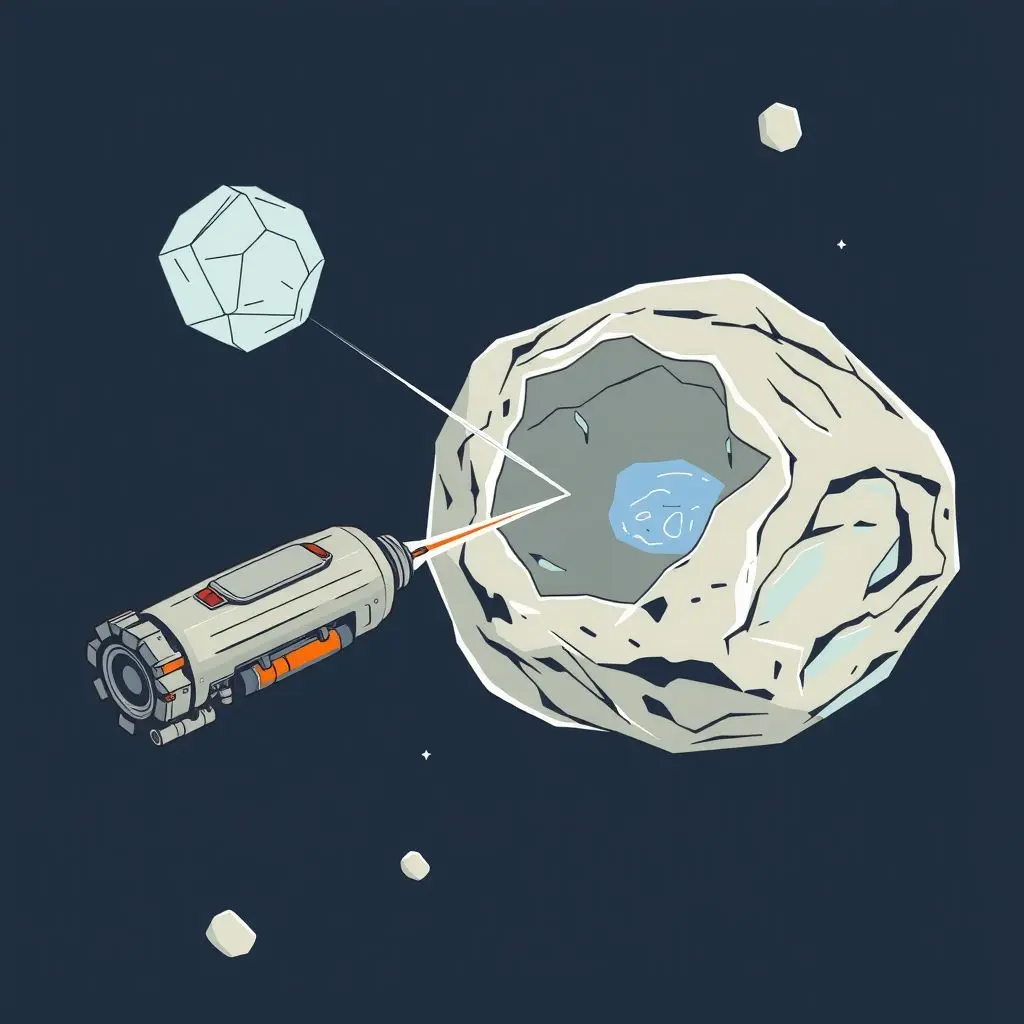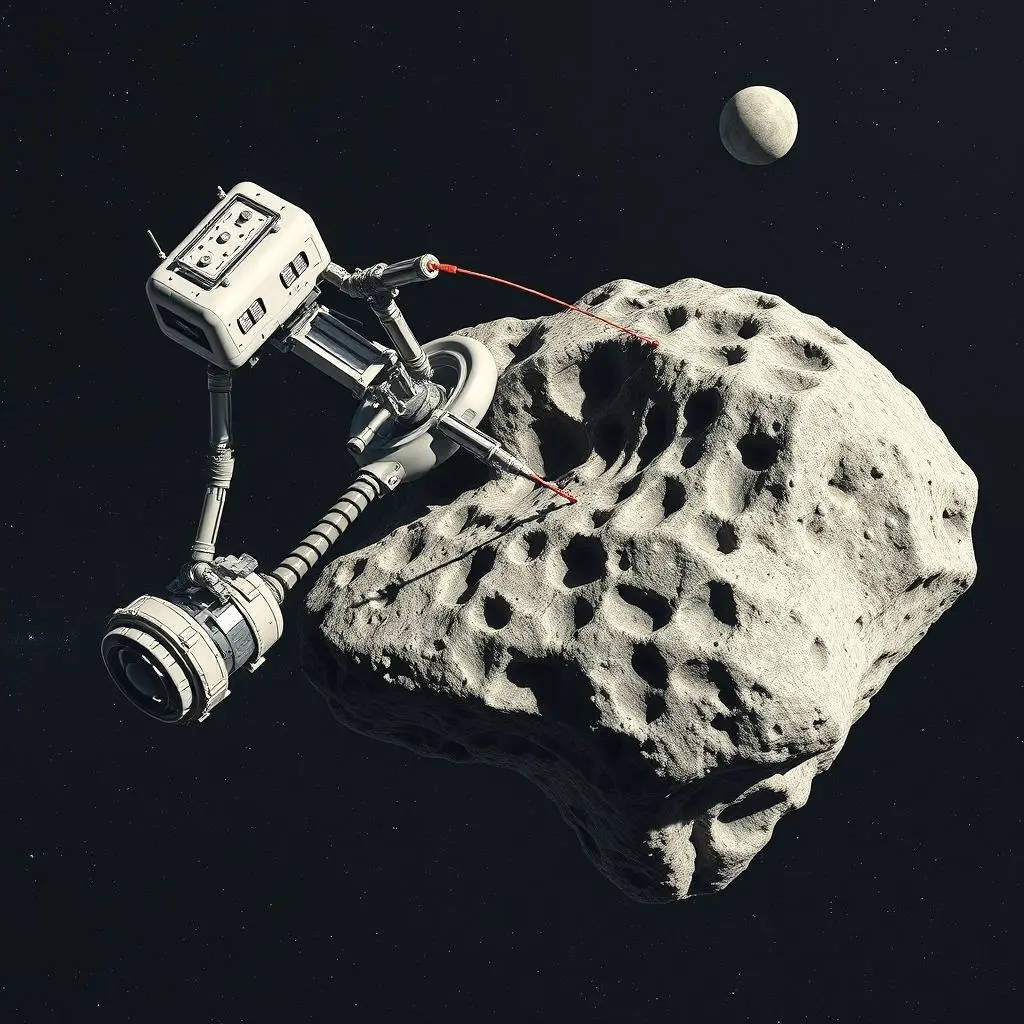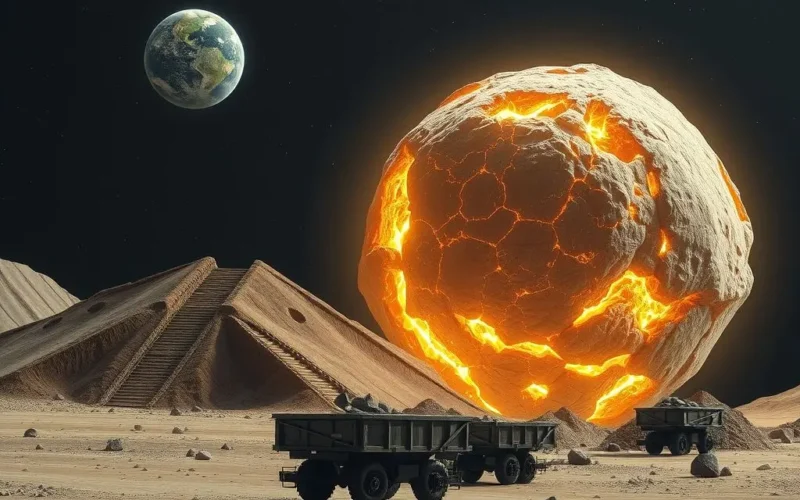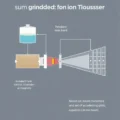For generations, we’ve looked up at the night sky and dreamed of exploring the cosmos. We’ve pictured brave pioneers blasting off in starships, venturing to distant worlds. And in countless science fiction tales, one idea has consistently captured the imagination: harvesting the riches hidden within asteroids.
Could vast space rocks truly hold the keys to unimaginable wealth – caches of precious metals, vital resources – just waiting to be claimed? For the longest time, it felt like pure fantasy, confined to movie screens and speculative novels. But what if I told you that vision is rapidly shifting from far-future speculation to tangible, present-day planning?
Prepare to have your perception of space exploration recalibrated. We’re not just talking about probes snapping pictures anymore. We’re entering an era where robotic fleets might head to asteroids, not for dramatic chase scenes, but for the very real purpose of extracting resources potentially worth trillions.
Want a quick hit of just how mind-bending this reality is becoming? Check out this short cosmic dispatch:
Table of Contents
Why Are We Even Thinking About Mining Asteroids?
The simple answer boils down to two things: scarcity on Earth and opportunity in space.
Earth’s Finite Resources Meet Growing Demand
Our planet is rich, but not infinitely so. Resources like platinum, palladium, rhodium, gold, and other rare-earth elements are crucial for modern technology – everything from catalytic converters and electronics to renewable energy systems and medical devices. Extracting them on Earth is becoming increasingly difficult, environmentally impactful, and expensive. As demand grows, the search for alternative sources intensifies.
Asteroids, on the other hand, are believed to be remnants from the formation of our solar system. Many are thought to contain significant concentrations of these very elements, delivered by different geological processes than those on Earth. Some estimates suggest that a single, relatively accessible asteroid could contain more platinum group metals than have ever been mined in human history on Earth.

Fueling the Space Economy
Beyond providing valuable materials for Earth, asteroid mining is seen as a crucial step in building a sustainable presence beyond our home planet. Transporting anything, especially large amounts of material, from Earth’s surface into space is incredibly expensive due to the energy required to escape Earth’s gravity. Imagine trying to build a lunar base or assemble a large spacecraft in orbit using only materials launched from Earth. It would be prohibitively costly.
Resources mined from asteroids, particularly water (H₂O), could be processed in space to create rocket fuel (liquid hydrogen and liquid oxygen). Establishing “fuel depots” sourced from asteroids would dramatically reduce the cost and increase the feasibility of missions to the Moon, Mars, and beyond. Iron and nickel from asteroids could also be used as structural materials for constructing spacecraft, habitats, or infrastructure in orbit or on other celestial bodies, effectively building with space resources in space.
What Riches Are Locked Away in These Space Rocks?
Asteroids aren’t uniform lumps of rock; they come in various types, each with different compositions. The ones most interesting for mining fall primarily into a few categories:
- C-type (Carbonaceous): These are the most common type and are rich in water (often bound in clay minerals) and organic compounds. The water content is a major draw for in-space use (fuel, life support).
- S-type (Stony): Composed mostly of silicate materials, these asteroids can contain significant amounts of metals like iron, nickel, cobalt, and potentially precious metals like gold and platinum group metals (PGMs).
- M-type (Metallic): Though less common, these are particularly interesting as they are thought to be the remnants of the metal cores of differentiated protoplanets. They are exceptionally rich in iron, nickel, and often very high concentrations of PGMs. The asteroid 16 Psyché, the target of a current NASA mission, is a prime example of an M-type asteroid, speculated to be worth quadrillions if its metals could be returned to Earth (a massive technological challenge).
The Allure of Platinum Group Metals (PGMs)
PGMs – platinum, palladium, rhodium, ruthenium, iridium, and osmium – are incredibly valuable due to their unique catalytic properties, resistance to corrosion, and high melting points. They are critical components in many high-tech applications. Their scarcity on Earth makes their potential abundance on certain asteroids incredibly enticing.
Water: The “Holy Grail” for Space Expansion
While PGMs might grab headlines for their potential terrestrial market value, water is arguably the most strategically important resource for enabling widespread space activity. It can be split into hydrogen and oxygen for rocket propellant, used for life support in habitats, and even radiation shielding. Finding abundant, accessible water in space dramatically lowers the bar for sustained operations beyond Earth orbit.

The “How”: Navigating the Challenges of Cosmic Extraction
Okay, so the resources are there, and the motivation is clear. But how do you actually get to an asteroid, extract materials, and bring them back (or process them in space)? This is where the “sci-fi tech” element truly comes into play, requiring significant technological advancements and overcoming daunting challenges.
Reaching and Grappling the Asteroid
First, you have to get there. Asteroids are diverse in size, spin rate, and composition. Some are rubble piles, others solid rock. Landing on or even operating near one requires sophisticated navigation and control systems. Techniques being explored include robotic arms, harpoons, nets, or even enclosing small asteroids in bags.

Extraction Methods
Once at the asteroid, different methods will be needed depending on the resource and asteroid type:
- Surface Mining: For loose regolith or small particles, scooping, excavation, or vacuuming might work.
- Drilling/Excavation: For more solid rock, traditional mining techniques like drilling, cutting, or even using focused energy beams would be required. This is complex in a microgravity environment.
- Volatiles Extraction: For water or other volatile compounds, heating the asteroid material in a contained environment to vaporize the substances, then condensing them, is a likely approach. This is particularly relevant for C-type asteroids.
- Magnetic Separation: For metallic asteroids, magnetic systems could potentially separate metal particles from other material.
Processing In-Situ (ISRU – In-Situ Resource Utilization)
Bringing raw asteroid material back to Earth is incredibly difficult and expensive, mainly feasible for extremely high-value, low-volume materials like PGMs (and even then, the scale and cost are immense). A more practical approach for bulk materials and propellants is processing the resources at the asteroid or at a nearby space depot. This In-Situ Resource Utilization (ISRU) involves compact, automated refineries and processing plants that can operate in the harsh vacuum and temperature extremes of space.
Legal and Economic Hurdles
Beyond the technical challenges, significant legal and economic questions remain. Who owns the resources on an asteroid? How would claims be established and defended? What would be the economic impact on Earth’s markets if vast quantities of materials like platinum suddenly became available from space?
Several nations are working on legal frameworks, but international consensus is still developing. The economic viability is also uncertain – the immense upfront cost of developing the technology and infrastructure must be weighed against the potential returns, which are speculative at this point.
Current Missions and Future Prospects
While full-scale mining operations are still some years away, foundational steps are being taken:
- NASA’s OSIRIS-REx: Successfully collected a sample from asteroid Bennu (a C-type) and returned it to Earth, demonstrating rendezvous, sample collection, and return capabilities.
- JAXA’s Hayabusa2: Similarly, collected samples from asteroid Ryugu (also C-type) and returned them, proving crucial technologies.
- NASA’s Psyché Mission: Currently en route to the M-type asteroid 16 Psyché, this mission will study its composition, providing invaluable data about metallic asteroids and their potential as resource sites.

Several private companies have also emerged with ambitious plans for asteroid mining, though many are still in early stages of development or pivoted to more near-term goals like satellite servicing. However, the core concept remains a long-term objective for some.
The Ripple Effect: Shaping Our Future in Space and on Earth
Successful asteroid mining could fundamentally alter our trajectory as a spacefaring species. Imagine:
- Lower Cost Space Travel: Abundant in-space fuel makes travel to the Moon, Mars, and the outer solar system far more accessible and cheaper.
- Permanent Space Infrastructure: Building materials sourced from asteroids could enable construction of large space stations, orbital habitats (like O’Neill cylinders), or infrastructure on the Moon or Mars without launching everything from Earth.
- New Industries: A completely new space resource industry would emerge, creating jobs and technological innovation.
The impact on Earth’s economy is harder to predict. While access to space resources *could* theoretically lower prices for certain rare materials, the massive scale and complexity of bringing bulk materials to Earth are immense. It’s more likely that the primary value, especially initially, will be in using these resources in space.
Exploring Common Questions
Q: Could asteroid mining make millionaires out of everyone with cheap gold/platinum?
A: Highly unlikely, at least in the near future. The cost and complexity of retrieving and refining materials from asteroids are astronomical. If massive quantities were returned, it could potentially disrupt Earth markets, but that’s a huge ‘if’. The real initial value is in resources used *in space* (like water for fuel) which reduces the cost of space activity.
Q: Are there legal agreements about who owns asteroids?
A: The Outer Space Treaty of 1967 states that outer space is not subject to national appropriation. However, it doesn’t explicitly forbid the *use* of resources. Several countries (like the USA and Luxembourg) have passed national laws permitting their citizens/companies to extract and own space resources, but an international legal framework is still needed to avoid potential conflicts.
Q: How do we know what’s in an asteroid?
A: Scientists use spectroscopy and thermal imaging from Earth-based and space telescopes to analyze the light reflected or emitted by asteroids, which gives clues about their composition. Missions like OSIRIS-REx and Hayabusa2 have also returned samples for direct study. The Psyché mission will provide unprecedented data on a metallic asteroid.
Q: Is there enough water on asteroids to matter?
A: Yes, C-type asteroids and potentially icy bodies in the outer solar system are believed to contain significant amounts of water ice, locked within minerals or as pure ice. Accessing even a few accessible, water-rich near-Earth asteroids could provide enough propellant and life support for substantial space operations for years.
Looking Towards a Resourceful Future
Asteroid mining is a concept that is rapidly transitioning from the realm of theoretical possibility to engineering challenge. It’s a powerful driver for innovation in robotics, propulsion, materials science, and autonomous systems. While significant hurdles remain – technical, economic, and legal – the potential rewards are immense: unlocking resources vital for technological advancement on Earth and, perhaps more importantly, enabling humanity’s expansion into the solar system.
The next great ‘gold rush’ might not be on Earth, but among the stars, powered by robotic prospectors exploring cosmic veins of wealth. It’s a vision that excites engineers, economists, and futurists alike, pushing the boundaries of what we thought was possible.



